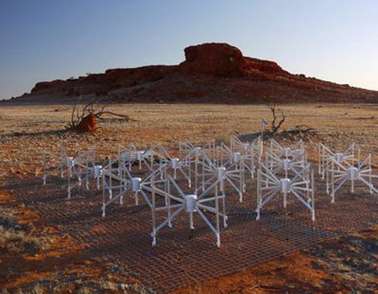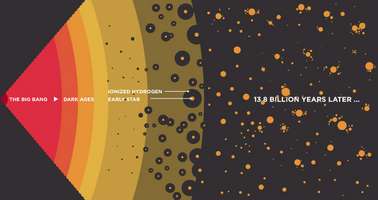Writing the history of the 'Cosmic Dark Ages'

For millions of years after the Big Bang, there were no stars, or even galaxies to contain stars. During these "Cosmic Dark Ages," neutral hydrogen gas dominated the universe. When clouds of primordial hydrogen gas started to collapse from gravity, they became stars. The infant stars' nuclear reactions emitted ultraviolet radiation, stripping the surrounding hydrogen atoms of their lone electrons, making them ionized.
This launched the Epoch of Reionization, when young stars burned away the neutral hydrogen, creating pockets of ionized hydrogen around the first cosmic objects. However, this chapter of the universe's life story is largely blank. We don't know how long it took the first stars to form, or even when they began to do so.
Using radio telescopes, scientists from ASU's School of Earth and Space Exploration are working with a multinational team to probe deep into our universe's mysterious formative eons, searching for answers to fundamental questions about this time period.
"We know a lot about the Big Bang, we know a lot about how the universe started and a lot about how the universe looks today, but for most of the first billion years we have almost no observations," says Judd Bowman, an assistant professor in the school.
Bowman is the project scientist for the Murchison Widefield Array (MWA), one of two low-frequency radio telescopes attuned to the unique redshift wavelength that neutral hydrogen emits. The other is the Precision Array to Probe the Epoch of Reionization (PAPER), which SESE postdoctoral fellow Danny Jacobs works on, along with the MWA.
Unlike most radio telescopes, both PAPER and the MWA are not dishes, like the National Radio Astronomy Observatory's Very Large Array (VLA).
"Normally, when you're building a radio telescope, you're building a dish," says Jacobs. "Waves come in and bounce to a central point, which focuses your field of view very tightly on the sky."
PAPER and the MWA are comprised of many separate, small antennae arranged in groups, providing a broad view of the sky. Jacobs compares the function of MWA and PAPER to wide-angle camera lenses. Dish telescopes like the VLA are more like standard or zoom lenses that can focus on one area very accurately.
Both arrays function similarly to cameras, as well. Just like light hits a digital camera's sensor to create an image, radio waves hit the arrays in different places with different intensities, giving researchers a "picture" of where those signals come from and, consequently, an idea of how the first bubbles of ionized hydrogen formed.
To pick up the faint signals from the Epoch of Reionization, both arrays have been constructed in very remote locations. PAPER's 128 antennas are spread across the Karoo desert in South Africa. The MWA consists of more than 2,000 elements located in Western Australia's outback.

"The reason we go there is to minimize radio frequency interference. Anything from phones, computers and lights generate radio interference that swamps our signal," says Jacobs. "It's so bad we have to go to the most remote parts of the world and our telescopes still detect satellites and planes, and reflections from meteors."
Discover the latest in science, tech, and space with over 100,000 subscribers who rely on Phys.org for daily insights. Sign up for our free newsletter and get updates on breakthroughs, innovations, and research that matter—daily or weekly.
Hydrogen's rest wavelength (the distance it takes for the wave's shape to repeat itself) is 21 centimeters. However, both arrays are tuned to much longer wavelengths. Due to the expansion of the universe, radio waves from hydrogen during Cosmic Dawn are stretched out to multiple meters by the time they reach Earth.
Both MWA and PAPER are stepping-stones to a larger project called the Hydrogen Epoch of Reionization Array (HERA), a massive radio telescope that will be capable of observing the cosmic processes that led to the universe as we see it today.
But even the basic components of those processes remain in question. Did stars form first, or galaxies, or black holes? HERA will help determine which was the inaugural celestial body.
"It's a chicken or egg problem," says Bowman. "All of those things today show up in the same place. Our Milky Way is one of billions of known galaxies and it contains billions of stars, and at its center is a supermassive black hole. So today, we see all of these objects interacting together. But which came first?"
Determining the incipient object will also shed light on everything that followed it. The first stars and galaxies would have had a tremendous influence on the neutral gas around them, altering the formation process of the next generation of objects. Understanding these effects is just as important as finding the objects themselves.
"Did the first objects make it easier or harder for more stars to form?" asks Bowman. "Did they make it so only big galaxies were able to survive through time, or did they allow little galaxies to thrive and grow?"
Such far-reaching, fundamental questions require a huge effort from people all over the world. ASU's contribution alone comes from researchers and students of all levels from SESE, Physics and the joint Cosmology Initiative.
"When a project gets to the scale we're talking about, with hundreds of antennas, the science is very hard, the analysis is very hard, you have to draw on the resources of the entire community to make it happen," says Bowman.
Actually, MWA and PAPER are competing projects. The most effective methods and processes from each telescope will be carried over to HERA when construction begins next year.
"But we're one team when it comes to the next generation," says Bowman. "It's an interesting form you see in science a lot, where competitors can be collaborators at the same time."
The difficulty and complexity of this long-term project is actually what most interests Bowman, who began work on the MWA when he was a grad student at MIT in 2005.
"What's exciting to me is working on a project that is hard, a project that takes time and real effort," says Bowman. "I want to see something that's never been seen before, I want to learn something that's important to the history of our universe."
Jacobs is also motivated by curiosity.
"I want to live in a world where we can, as a society, ask lots of questions about our world. Whether or not they're useful shouldn't matter because we are curious people ... and the more we know about the universe, the better off we are," says Jacobs.
Provided by Arizona State University


















